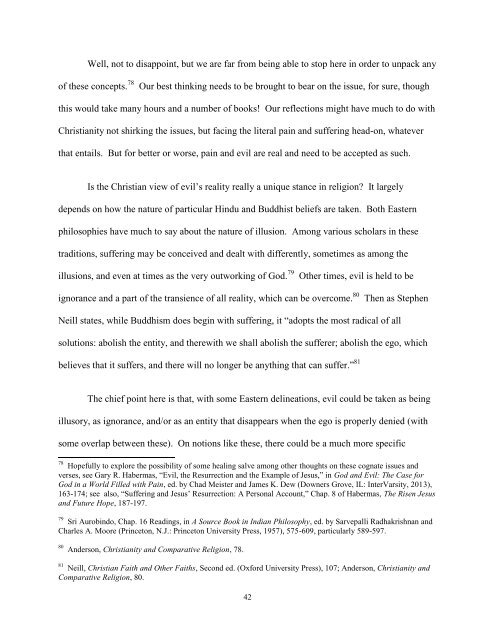Published by
299z7CN
299z7CN
Create successful ePaper yourself
Turn your PDF publications into a flip-book with our unique Google optimized e-Paper software.
Well, not to disappoint, but we are far from being able to stop here in order to unpack any<br />
of these concepts. 78<br />
Our best thinking needs to be brought to bear on the issue, for sure, though<br />
this would take many hours and a number of books! Our reflections might have much to do with<br />
Christianity not shirking the issues, but facing the literal pain and suffering head-on, whatever<br />
that entails. But for better or worse, pain and evil are real and need to be accepted as such.<br />
Is the Christian view of evil’s reality really a unique stance in religion? It largely<br />
depends on how the nature of particular Hindu and Buddhist beliefs are taken. Both Eastern<br />
philosophies have much to say about the nature of illusion. Among various scholars in these<br />
traditions, suffering may be conceived and dealt with differently, sometimes as among the<br />
illusions, and even at times as the very outworking of God. 79<br />
Other times, evil is held to be<br />
ignorance and a part of the transience of all reality, which can be overcome. 80<br />
Then as Stephen<br />
Neill states, while Buddhism does begin with suffering, it “adopts the most radical of all<br />
solutions: abolish the entity, and therewith we shall abolish the sufferer; abolish the ego, which<br />
believes that it suffers, and there will no longer be anything that can suffer.” 81<br />
The chief point here is that, with some Eastern delineations, evil could be taken as being<br />
illusory, as ignorance, and/or as an entity that disappears when the ego is properly denied (with<br />
some overlap between these). On notions like these, there could be a much more specific<br />
78 Hopefully to explore the possibility of some healing salve among other thoughts on these cognate issues and<br />
verses, see Gary R. Habermas, “Evil, the Resurrection and the Example of Jesus,” in God and Evil: The Case for<br />
God in a World Filled with Pain, ed. <strong>by</strong> Chad Meister and James K. Dew (Downers Grove, IL: InterVarsity, 2013),<br />
163-174; see also, “Suffering and Jesus’ Resurrection: A Personal Account,” Chap. 8 of Habermas, The Risen Jesus<br />
and Future Hope, 187-197.<br />
79 Sri Aurobindo, Chap. 16 Readings, in A Source Book in Indian Philosophy, ed. <strong>by</strong> Sarvepalli Radhakrishnan and<br />
Charles A. Moore (Princeton, N.J.: Princeton University Press, 1957), 575-609, particularly 589-597.<br />
80 Anderson, Christianity and Comparative Religion, 78.<br />
81 Neill, Christian Faith and Other Faiths, Second ed. (Oxford University Press), 107; Anderson, Christianity and<br />
Comparative Religion, 80.<br />
42


